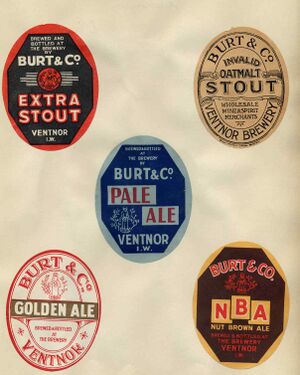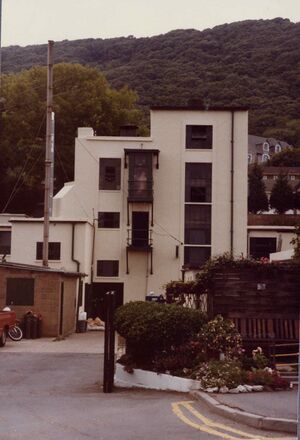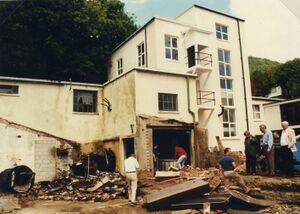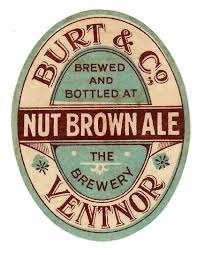Burt & Co
Burt & Co, 119 High Street, Ventnor, Isle of Wight.
Founded 1840. Acquired by Albert Phillips in 1906. The site was bombed in 1943 and rebuilt in 1953.
The company continued trading under the name of Burts until 1992, but went into receivership and brewing ceased.
Acquired by Hartridge & Sons Ltd in 1993 with 12 houses. Hartridge at this time already owned the Island Brewery (Newport); they adopted the Burt's name and brewing moved to the Island Brewery premises in Sandown.
In 1996, the Ventnor site reopened as Ventnor Brewery.
Burt and Co. First published in The Brewer, March, 1986
Probably the start of the company now known as Burt and Company of Ventnor, occurred a mere 145 years ago when the then owner of the brewery, Mr. James Courbould came to a special arrangement with Mr. Thomas Page the proprietor of the water company to receive a limitless supply of untreated spring water from the chalk downs for the sum of six pence per year fixed for 1,000 years! Despite scrutiny by the council water authority, the contract could not be faulted so the brewery continued to enjoy one of the cheapest municipal water rates in the country right up until it closed in 1992.
A brewery had existed on the site, although not in the same form, since the early nineteenth century. The actual foundation date is generally accepted to be 1840 under the control of James Courbould. The Courboulds remained involved in the brewery for 37 years, in the latter years in partnership with Mr. John Burt who took over completely in 1881. However, the trading name of "Burts" conceals the fact that the brewery has been owned and managed by three generations of the Phillips family, with each generation of owner-brewer being personally concerned with the quality of the product.
Burts was acquired by the Phillips family in 1906 by Albert Phillips who, although born on the Island in Brading in 1847, left as a young man with less than £1 in his pocket to seek his fame and fortune. He found work in Portsmouth in the licensing trade, and his obvious success reflected in his ability to have returned some years later to buy the brewery for £14,500. When Albert died in 1916, the business was continued by his son William Arthur Phillips who built up the business by acquiring further public houses to add to the six owned in 1906.
Jack Phillips who, along with his brother Bill, took over from his father as head brewer in 1943. They brewed until Bill's death in 1978, since when Jack was assisted by the fourth generation in the person of his son Alistair.
The only event to have disrupted production was a direct hit by a German bomber on 17th January, 1943, which was aiming for the radar installations on the Downs at the back. The brewery was severely damaged and tragically three members of the family were killed--Jacks' wife Mary, his father William Arthur, and the youngest sister Pamela, in the neighbouring family house.
Following the extensive wartime damage, the brewery site was reconstructed to take its present form. The same traditional arrangement was followed the modernised brewery being largely functional, while the brewers house, office block and off licence were built to resemble a Georgian facade reflecting the period when living with the business was common practice.
The brewery itself was planned to achieve efficiency and economy of labour and power. The building is based on the tower principle with the cold liquor tank on the top floor. Damage necessitated the replacement of the sugar and hop store, but the bottling plant with its hand labelling operation remains unchanged. Cellars run the length of the building where the beer is racked into cask for direct supply of cask beer or transfer to the bottling stores. Reconstruction allowed for some modernisation, but many of the features of the original brewery have remained unaltered.
The brewery brews two basic qualities--a light bitter and a heavy bitter. From these a mild, an ordinary and best bitter are produced as well as a "Four X," which are available on draught. In addition the brewery bottles a pale ale, brown ale, India pale ale and XXXX.
The brewery only handles bagged malt in 10 tonne loads, and one load last about three weeks. The brewery follows a traditional process with a Porteous four roller mill, Maitland masher and isothermal mash tun. After boiling the wort is cooled through an open milk cooler before collection of open squares. Fermentation is complete in 48 hours, and the beer is racked on the third day, remaining in cask for a further three days to mature.
Production is 9,000 barrels of beer in a year with a labour force of nine. Distribution around some 100 outlets on the island is by two five ton Bedford trucks, covering hotels, pubs and holiday establishments in the free trade.
Transport costs mean that is not profitable to ship beer to the mainland and the trading area is restricted to the island itself. This allows the brewery to maintain a very competitive price structure which would be lost by "exporting”.
Distribution is centred on eleven tenanted pubs owned by the brewery, the majority of which are based in Ventnor, although locations spread throughout the Island, with the most westerly pub being the Standard at Freshwater and as far east as the Chine in Shanklin.
The pubs are steeped in local history, and although the first pub was acquired in 1844, many had been trading long before the brewery was built. The Terminus hotel followed the building of the railway in 1866 when Ventnor was the end of the line. It was leased by John Burt in 1870 and bought in 1906. Among the older pubs, the Chine Inn was a collecting place for smugglers bringing in illicit brandy from France. This was the principal occupation of much of the West Wight in the eighteenth century, but not necessarily the forerunner of the profitable wines and spirits business which accompanies the brewery.
Another old pub is the Hare and Hounds at Arreton where one of the ceiling beams is reputed to be part of the scaffold used to hang the murderer Michael Morey in 1735. However, looking at the length of the beam today, it casts some doubt over the story, and the legend may have no more to do with the human skull in the corner of the bar than to the hanging of a local villain! Many of the Burts pubs have their history and myth closely interwoven with that of the Island.
Burts has been producing traditional beers, concentrating on a local market for 145 years, which shows they have found a recipe for success which is as popular as the beer itself.
The brewery in 1989: photos by Jeff Sechiari
Various images of the brewery






















